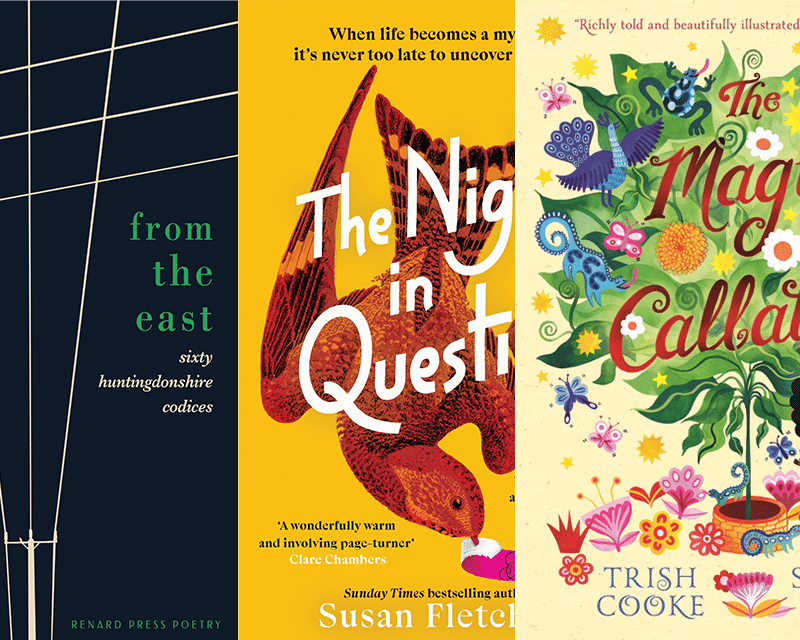- Collected
- Article
We’ve Got Rhythm
Words are ingredients, it's how you blend them that gives them power

- 18 May, 2015
- Bill Kirton
I always advise would-be writers to read their work aloud, no matter how embarrassing it feels to be performing and emoting to an empty room. If it was good enough for Flaubert, who used to wander up and down his ‘gueuloir’ (shoutery), testing the feel of his phrases on his tongue and in his ears, it’s good enough for the rest of us. Reading aloud reveals mistakes, repetitions, faulty punctuation, as well as things that just ‘don’t feel right’. Most of all, reading aloud brings home the importance of rhythm.
The manipulation of rhythm is a part of the writer’s skill set that’s often overlooked. It’s an obvious element in poetry, but I’d argue that it is just as important in stories, novels, even essays: as timing is to the sportsman or comedian, so rhythm is to the writer.
I’m no theorist about this but I think there must be an instinctive psychological response to rhythms at a level beyond the rational. They’re everywhere, in the patterns of our days and nights and the progression of the seasons. Our heartbeat and breathing, the feel of walking or running; they’re all rhythmic, reliable, reassuring. In many different cultures, ritual drumming, the incantations of holy men and the chanted responses of their congregations bring people together in a shared, transcendent experience, even inducing trance-like states that free us from the confines of our individual consciousness. Psychological experiments confirm that brainwaves resonate in time with rhythms: a slower beat can induce a meditative state, while faster ones create excitement and encourage concentration and clear thinking. It may seem mystical, but in fact it’s visceral.
So how do writers exploit this to convey their messages? At the surface level, they use semantics, with its signifiers and other linguistic elements. But the way in which these are combined has its own communicative power. For example, I don’t think it matters in the slightest if you don’t know the ‘meaning’ of:
And pluck till time and times are done The silver apples of the moon, The golden apples of the sun.
The combination of images and rhythms there is enough to give you a feeling of wonder.
But I’m not just referring to poetic resonances and high-flown imagery. In fact, what started me thinking about this was the death in 2013 of the great Elmore Leonard, whose rhythms, whether through the fractured dialogues of his characters, or in the spare perfection of his own prose, are central to the pleasure of reading him. The opening to his Tishomingo Blues is often quoted to illustrate his mastery:
Dennis Lenehan the high diver would tell people that if you put a fifty-cent piece on the floor and looked down on it, that’s what the tank looked like from the top of that eighty-foot steel ladder … when he told this to girls who hung out at amusement parks they’d put a cute look of pain on their faces and say what he did was awesome. But wasn’t it like really dangerous?
It’s deceptively simple, flows off the tongue, conveys the necessary information, and has those binding little echoes in ‘fifty-cent’ and ‘eighty-foot’. The economy of characterisation in ‘girls who hung out at amusement parks’ and ‘put a cute look of pain on their faces’ is delightful (to me anyway), and the fluidity of that opening sentence is enhanced by its contrast with the brief, broken one that follows it. Leonard’s much-lauded ear for dialogue is just part of his sensitivity to the wider rhythms of language.
Poetry, with its more formal structures and easily identifiable rules about where stresses should fall, exemplifies clearly the power of rhythm. Shakespeare’s ‘Shall I compare thee to a summer’s day?’, for example, is a typical iambic pentameter; in other words, a line of five iambs, or: five pairs of syllables in each of which the stress falls on the second. Switch the stress to the first syllable and the iamb becomes a trochee, as in Longfellow’s:
By the shores of Gitche Gumee, By the shining Big-Sea-Water, Stood the wigwam of Nokomis, Daughter of the Moon, Nokomis.
The difference is clear: while the first has a soft, gentle effect, the second is more declamatory, incantatory, some might even say less ‘natural’. But then, see what happens when the ‘rules’ are ‘broken’ as when Hamlet begins to muse on suicide. Instead of:
To be, or not to be — that is the question[…]
let’s give him a regular iambic pentameter:
The question is — to be or not to be[…]
The difference is striking. Follow the rules and you have a balanced, reflective statement of a mind in control. There’s none of the anxiety or disruption conveyed by the strong intrusion of the arrhythmic ‘That is the question’.
Then there are the more complicated metres in which stressed and unstressed syllables form different combinations, and create different effects, such as the anapaestic tetrameter with its three beats (weak, weak, strong), used by Byron for the ‘galloping’ rhythm of:
The Assyrian came down like the wolf on the fold
And his cohorts were gleaming in purple and gold;
and, incidentally, by Queen as the rhythm underpinning their stadium anthem ‘We Will Rock You’.
In music, poetry and prose alike, if the rhythm’s not right, the words or lyrics have less impact; that’s fine if it’s deliberate but not if you’re unaware of it. Do it right and you can influence the reader by soothing or disturbing her with gentler cadences or unsettling stresses, such as those exploited most notably by writers of poetic drama.
In Marlowe’s Tamburlaine the Great, a Persian Lord, Meander, tells the king ‘Your majesty shall shortly have your wish, / And ride in triumph through Persepolis.’ To which the king replies:
‘And ride in triumph through Persepolis’? Is it not brave to be a king, Techelles?
Usumcasane and Theridamas, is it not passing brave to be a king, and ride in triumph through Persepolis?
These are all iambic pentameters but I’ve dispensed with the line breaks to show that it makes no difference to their impact. The rhythms live in the words, not in the imposition of external rules of prosody.
The lines carry an unquestionable nobility, but the use of rhythm goes beyond mere heroic resonance. Othello, for example, was a great orator, with lines such as:
Farewell the neighing steed and the shrill trump, the spirit-stirring drum, th’ear-piercing fife, the royal banner, and all quality, pride, pomp, and circumstance of glorious war!
But his self-assurance and conceit break down when Iago hints at Desdemona’s alleged infidelity, and his loss of control is reflected in his language.
It is not words that shake me thus. — Pish! Noses, ears, and lips? Is’t possible? —Confess? — Handkerchief? — O devil!
So rhythm works not just through its own power and consistency but when it’s overwhelmed. This is even more obvious in French, a language with regular, predictable stress patterns. In France, classical drama was highly formal and aimed to replicate the rhetorical structures of Greek tragedy, or at least, 17th century France’s interpretation of the ‘rules’ outlined in Aristotle’s Poetics. So it was written in Alexandrines, the formal structure underscoring the pre-eminence of those speaking the words. All the main characters in classical tragedy are high born. Their control of language is a mark of their superiority, culture and social standing. If you like, it’s another of their identifying masks. So when they seem to stumble over syllables, we know the ordinary mortal beneath the facade is having trouble suppressing baser instincts or just plain human emotions.
But, even away from the strict formality of a prescribed pattern, rhythm rules. Compare the percussive and allusive grandeur of Dylan Thomas’s:
And death shall have no dominion.
Dead men naked they shall be one
With the man in the wind and the west moon;
When their bones are picked clean and the clean bones gone,
They shall have stars at elbow and foot;
with what a New York Times critic called the ‘lean, hard, athletic narrative prose’ of Hemingway:
Robert Cohn was once middleweight boxing champion of Princeton. Do not think that I am very much impressed by that as a boxing title, but it meant a lot to Cohn. He cared nothing for boxing, in fact he disliked it…
From the measured, orchestrated aphorisms of Oscar Wilde to the exuberant vernacular of Joe Orton, or the silences and repetitions of dialogues in Pinter or Beckett, rhythms vary very widely, but they’re always there. And they predominate in many far less elevated contexts. When demonstrators congregate, their grievances or aspirations are most effective, most vehement, when they’re chanted. People clamouring for an end to a conflict, for example, don’t make complex speeches about negotiated settlements or diplomatic manoeuvres, they chant:
What do we want? Peace.
When do we want it? Now.
At football matches, tens of thousands of people suddenly, with no apparent signal, begin to sing and chant as one. Not only that, they do so in different languages and yet all use the same basic chants or rhythms. When it comes to proclaiming their allegiance, rhythm precedes words.
We obviously need rhythm. It’s a basic aspect of how we survive, of who we are as individuals in a social, global collective. Writers have to be aware of this and not only use it as a rhetorical device to convey a specific point, but also continuously match the tempo of their prose to the mood they wish to create. False beats and disturbing cadences can alienate readers at a subliminal level and deafen them to surface meanings. Repetitions can reinforce a point or undermine it if prolonged; there’s a fine line between exhorting and nagging.
So, if you read something aloud and it ‘doesn’t feel right’, don’t just look at what the words ‘mean’, check how they sound, examine the little echoes within and between them, feel the ebb and flow of stresses. Words are our ingredients: it’s the way we blend and balance them that gives them their power.
You might also like:
No facts, only versions
Memoirs are as much about what is excluded as what is included. This edition examines how you can evoke the…
RLF Fellows’ News: April 2024
Publishing News RLF Fellow Trish Cooke’s new children’s book, The Magic Callaloo, is set to be published by Walker Books…
Susan Fletcher on outsiders in fiction – literal and imagined
I’ve always known that I’ve preferred to be outside. To be an outsider – literally, and, specifically, amongst wild places…


